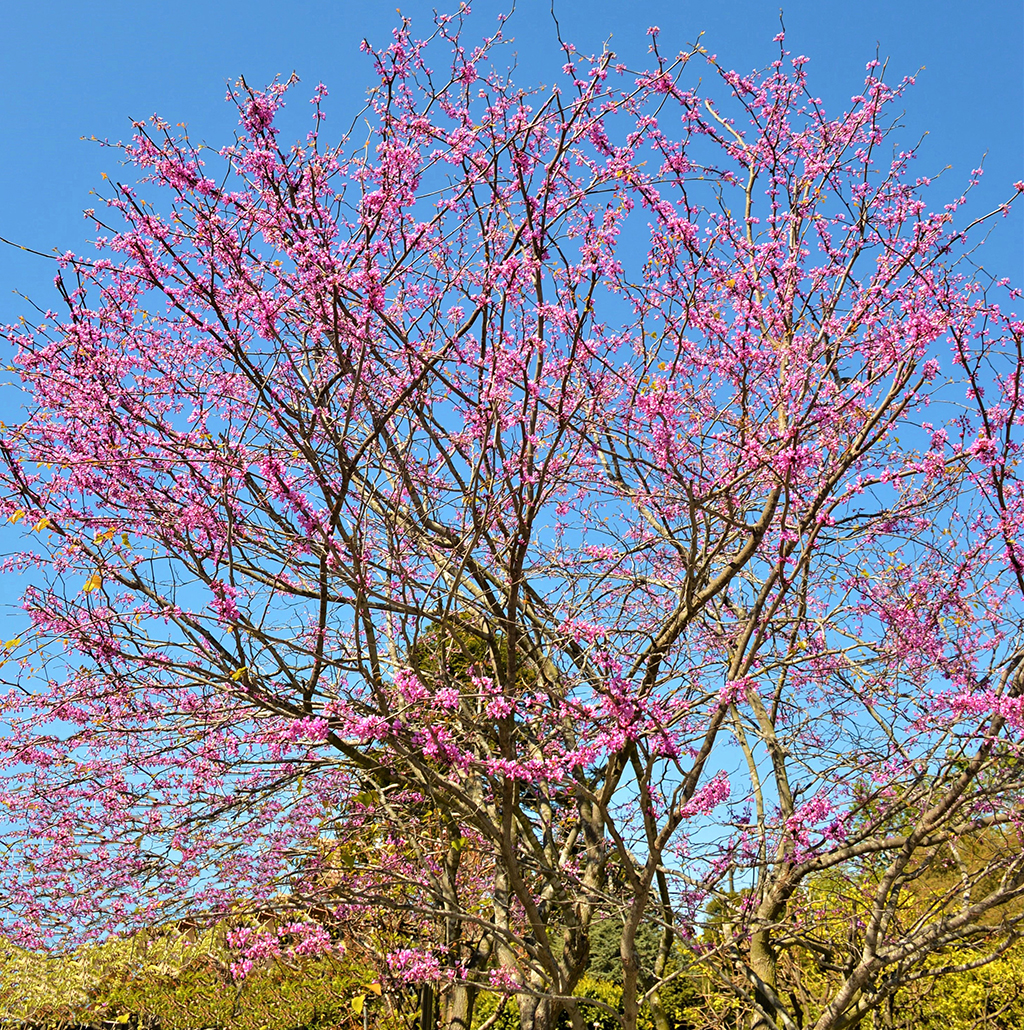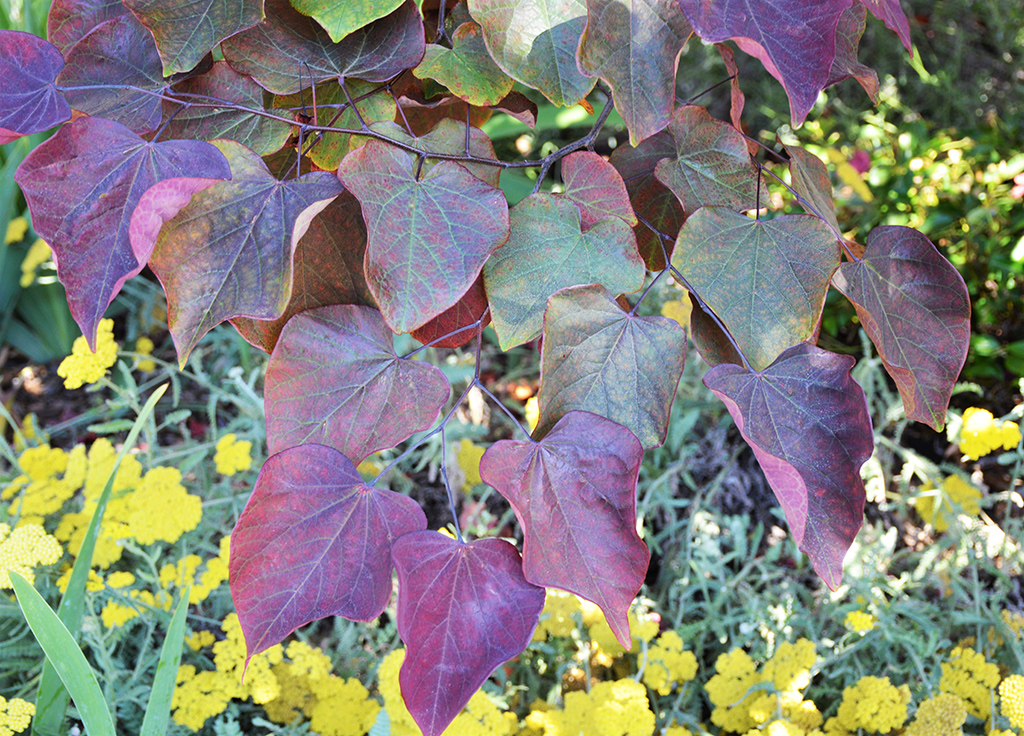Santa Barbara Beautiful Tree of the Month – March 2022

Cercis canadensis
Nothing says, “Spring is here!”, like a deciduous tree coming into full bloom. Even with the amazing variety of flowering trees that grow in our community, there is a special one that always captures our attention this time of year – the Eastern Redbud.
This may be somewhat surprising because it is a rather diminutive tree, reaching a maximum height and spread of only 20 feet.
Nevertheless, with its open and picturesque form, delicate branching, and petite blossoms, it creates as refined silhouette as you might see in a Japanese painting – and one that you will want to see in your own garden.
Its main attention-getters are its showy flowers – pops of magenta-pink against otherwise-bare, almost-black, narrow stems. Selected cultivars have white flowers. The flowers, shaped like pea blossoms, are tiny (½ inch wide), and are “perfect”, meaning they each have both male and female reproductive parts. Flowers typically occur in clusters of 4 to 10 that emerge along the stems and, remarkably, sometimes along the trunks. Sweet nectar is produced deep in the throats of these little flowers; only long-tongued bees, such as carpenter bees, can serve as pollinators.
All Redbuds are in the Legume family (Fabaceae); consequently, their pollinated flowers create seed pods (2- to 4- inches long) that look much like common snap peas, each containing 10 to 12 brown seeds (¼-inch long).
It has lovely foliage and, when fully-leafed, will resemble a tree full of paper Valentines! This is the result of each leaf being “cordate”, meaning “heart-shaped”. Growing to 3- to 5- inches long and wide, the leaves have smooth margins with pointed tips and are arranged in an alternating zig-zag pattern along the stems. Satiny-textured on their surfaces, they first appear in a muted green to blue-green color, which will turn yellow to light orange in the fall.
The Eastern Redbud is native to an immense area, stretching from southern Ontario in Canada, south to much of the United States, including New England, the Midwest, and the South, and then extending further into northern Mexico. In its natural setting, it is primarily an understory tree that grows along streams or on the edges of woodlands.
There is also a Western Redbud, Cercis occidentalis, a California native. It is distinctly different from Eastern Redbud and, therefore, will be featured in another Tree-of-the Month article.
The botanical name for Eastern Redbud is Cercis canadensis. The genus name, Cercis, comes from the Greek word, “kerkis”, meaning “weaver’s shuttle”, referring to the shape of its seed pods. The specific epithet, canadensis, refers to its native range in Canada.
Native Americans ate its flavorful and nutritious flower buds and flowers, either raw, boiled, or fried; seeds were also eaten, after proper cooking. Its green twigs have been used in traditional Southern Appalachia cooking as a seasoning for native game, giving the tree its common name of “Spicewood”.
Eastern Redbud is easy to grow, provided it is in an irrigated landscape with good drainage. In poorly drained heavy soils, it can develop severe root diseases. As an understory tree, it does best in partial shade, particularly in a hot location. If properly placed and kept healthy, it will be relatively free from pest and disease problems. It is a slow-growing tree that can be either low-branched, multi-trunked, or single-trunked; judicious early pruning will create the form you prefer. It is an excellent tree for smaller and more intimate landscape spaces.
Because of its unique beauty, Eastern Redbud has long been popular as an ornamental tree and planted, primarily, in city parks or in private yards. It can be enjoyed as an individual specimen – or, for added impact, installed in groups or in rows. Two especially delightful cultivars, ‘Forest Pansy’, and ‘Ruby Falls’, were found to be so outstanding that they received the Royal Horticultural Society’s Award of Merit. These cultivars are prized for their stunning purple to greenish-purple leaves and their brilliant fall color. ‘Ruby Falls’ has the additional feature of a gracefully weeping growth habit.
Although Eastern Redbuds are rarely used here as street trees, they do stand in our landscapes: in the front courtyard of the Carrillo Recreation Center (100 E. Carrillo Street); S.B. Architectural Foundation (229 E. Victoria Street); on the 500 block of N. La Cumbre Road; and, at the corner of Alston Road and Augusta Lane. They are more often seen in private yards and gardens. The white flowering variety can be seen in the Japanese Garden at Lotusland. Because they are such lovely trees, they really should be planted more frequently about town.
Tree-of-the-Month articles are sponsored by Santa Barbara Beautiful, whose many missions include the increase of public awareness and appreciation of Santa Barbara’s many outstanding trees and, in a long-time partnership with the City Parks & Recreation Department, the funding and planting of trees along the City’s streets.
Those who wish to honor a special someone can do so with an attractive commemorative marker that will be installed at the base of an existing street tree in the City of Santa Barbara. Because Santa Barbara Beautiful has participated in the planting to date of over 13,000 street trees, there are plenty of trees from which to choose! Application forms are available on the Santa Barbara Beautiful website, www.sbbeautiful.org.
Article and photos by David Gress


